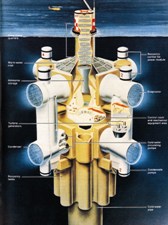Energy from the Sea
In the October 1978 issue of TR, William F. Whitmore invoked an idea from the 19th century: ocean thermal energy conversion, or OTEC. Exploiting the temperature difference between the sun-heated surface of tropical waters and the chilled depths thousands of feet below, Whitmore argued, could provide clean, renewable energy in the lower latitudes.

In the tropics, the oceans store an immense amount of energy from the sun. The band of surface water within 10º of the equator basks around at 80º F., while cold regions 3,000 ft. below are around 40º F. [OTEC] uses this thermal gradient, like the hot and cold terminals of a gas turbine, to generate electricity. The essence of the system is the circulation of a fluid such as ammonia or propane. Where it comes near the warm water it is brought to a boil and so expands; where it comes near the cold, it liquefies once again. In the course of its circulation from one place to another, it drives a power-generating turbine. A typical closed-loop system would include two exchangers (evaporator and condenser), a turbine, and a generator.
… The engineering challenges to be bridged demand solutions of scale rather than of technical innovation. Ship designs and structures used for offshore oil platforms have blazed the trail for the physical platform on which OTEC will be mounted. A general design goal is to isolate the platform as much as possible from the influence of the ocean surface, where the interaction of wind and wave can induce violent platform motions. A leading candidate is a large spar buoy configuration, with most of the platform mass several hundred feet underwater and a relatively small surfacepiercing mast for access; this would also give warning to marine traffic. The OTEC system, with power cabled to shore, is necessarily fixed in place. Both steel and concrete are considered as possible platform construction materials.
In the 1990s, 250-kilowatt test facilities in Hawaii’s tropical waters demonstrated OTEC’s feasibility. For a plant to be commercially viable in the United States, however, it would have to produce between 50 and 100 megawatts. Developing such plants would require “patient financing,” according to Luis Vega, test director of the largest test plant operated by the Pacific International Center for High Technology Research, which ran the Hawaiian facilities. The first step would be a prototype plant of a few megawatts. Ultimately, Vega believes, not only would a commercial-scale OTEC plant be viable, but it could operate at six to eight cents per kilowatt-hour, making it competitive with other renewable energy sources and even with fossil-fuel plants. But for now, the oceans remain untapped.
Keep Reading
Most Popular
Large language models can do jaw-dropping things. But nobody knows exactly why.
And that's a problem. Figuring it out is one of the biggest scientific puzzles of our time and a crucial step towards controlling more powerful future models.
How scientists traced a mysterious covid case back to six toilets
When wastewater surveillance turns into a hunt for a single infected individual, the ethics get tricky.
The problem with plug-in hybrids? Their drivers.
Plug-in hybrids are often sold as a transition to EVs, but new data from Europe shows we’re still underestimating the emissions they produce.
Google DeepMind’s new generative model makes Super Mario–like games from scratch
Genie learns how to control games by watching hours and hours of video. It could help train next-gen robots too.
Stay connected
Get the latest updates from
MIT Technology Review
Discover special offers, top stories, upcoming events, and more.